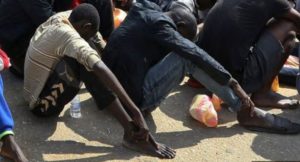Slave trade in migrants revealed
 Horrific images have emerged of migrants being sold at slave markets in Libya.
Horrific images have emerged of migrants being sold at slave markets in Libya.
The practice has been reported on before but the images, published this week by CNN, are the first concrete proof of the trade in humans.
On the published video young men are seen being auctioned off as farm workers.
The African Union (AU) immediately expressed outrage and promised to act to stop the trade.
AU chairman, President Alpha Conde of Guinea, demanded prosecutions over a “despicable” trade “from another era”.
Migrants trying to reach Europe have spoken of being held by smugglers and forced to work for little or no money.
The footage appears to show youths from Nigeria and other sub-Saharan countries being sold to buyers for about $US400 at undisclosed locations in Libya.
“These modern slavery practices must end and the African Union will use all the tools at its disposal,” Mr Conde told the media this week.
And the Libyan Government said it has opened an investigation into the practice.
The slave trade in Libya first came to international notice in April this year when the International Organisation for Migration (IOM) said it had evidence of the practice.
The IOM’s chief of mission for Libya, Othman Belbeisi, told the media at the time that migrants were priced according to their abilities.
“Apparently they don’t have money and their families cannot pay the ransom, so they are being sold to get at least a minimum benefit from that,” he said.
“The price is definitely different depending on your qualifications, for example if you can do painting or tiles or some specialised work then the price gets higher.”
Libya has been engulfed in chaos since NATO-backed forces overthrew long-serving ruler Col Muammar Gaddafi in October 2011.
Western powers are now becoming increasingly concerned that so-called Islamic State (ISIS) has built a presence in the North African state and the US has responded by launching air strikes on the militant group.
In Libya, a plethora of armed militias actually wield real power and some reports say often hold the politicians they supposedly back to ransom.
During the uprising, hundreds of armed groups emerged.
Libya has two rival parliaments and three governments – the latest government was formed in UN-brokered talks with the aim of replacing the other two.
But this initiative is still to be properly established, partly because of local concerns that the new government is being imposed on the population by Western powers.
The oil-rich country once had one of the highest standards of living in Africa, with free healthcare and free education, but six years on from the uprising, it is facing a financial catastrophe.
And the turmoil has allowed ISIS to gain a foothold in the country.
The extremist group has taken control of an “enclave” around the city of Sirte, the birthplace of Gaddafi. Security experts fear this could provide a safe haven for jihadists to train, fund and plan attacks in North Africa and across the Mediterranean.
However, pro-government forces backed by the West have now pushed back the Islamists and retaken the city.
Some security analysts describe Libya as an arms bazaar. It’s awash with weapons looted from Gaddafi’s arsenal – making an ideal playground for jihadists fleeing air strikes in Syria and Iraq.
ISIS has been attacking Libyan oil facilities, has kidnapped several foreign oil workers and in 2015 was behind two high-profile attacks on Tunisia’s tourism industry.
Tunisia has built a partial security barrier and trench along its border with Libya aimed at preventing further atrocities.
The US has carried out at least four known air strikes in Libya since 2015. The latest one, in January, targeted an alleged training camp on the outskirts of Sirte where some ISIS militants had fled after the city fell.
The UK and France also have special forces operating in the North African state – the nature and extent of these operations have largely been secretive.
Three French soldiers died in July 2016 when their helicopter was shot down by militiamen who identified themselves as belonging to a new militant group called Benghazi Defence Brigades (BDB).
Last year, plans were unveiled to send 6,000 troops from a number of NATO countries, including the UK and France, to Libya to train local troops to stop ISIS-linked groups from gaining more territory and to provide security to diplomatic missions that were looking to move back to the capital.
But the new unity government has been reluctant to openly allow or request the presence of foreign troops.
Laurie Nowell
AMES Australia Senior Journalist












